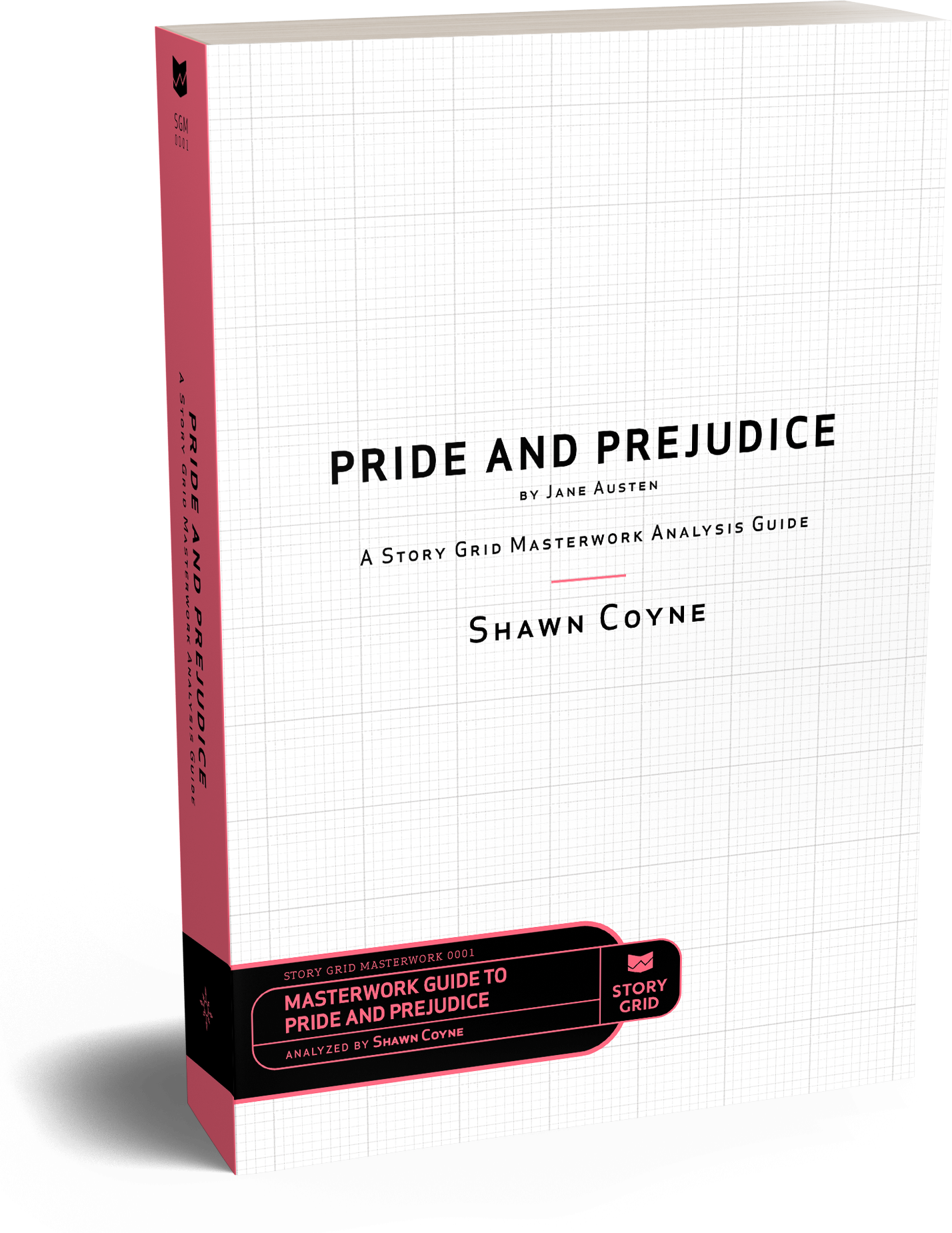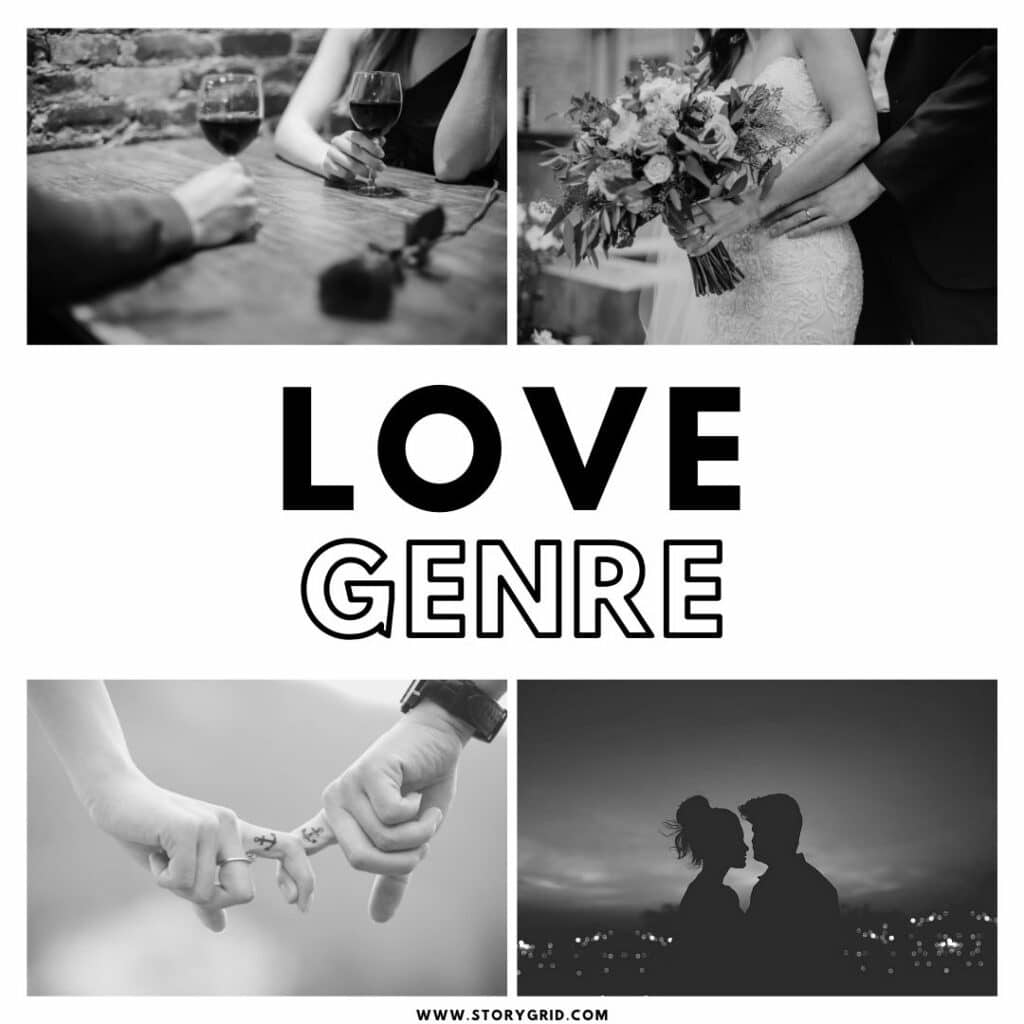What is the Love Genre?
An external story in the Love genre focuses on the need for connection in a variety of forms, including desire, commitment, and intimacy, allowing readers to identify with the lovers as protagonists and respond to the fulfillment of the couple’s fate on the hate-love spectrum with a feeling of romance.
The underlying question in every Love story is:
How do we navigate the emotional minefield that is love? How can we attract a mate, avoid heartbreak, and maintain a lasting relationship through a lifetime?

Access our In-depth Guide to the Love Genre
This 535-page books walks you scene-by-scene through Pride and Prejudice by Jane Austen, showing you exactly how to write a masterwork love story.
What is the Controlling Idea of the Love Genre?
The universal theme or CONTROLLING IDEA of a Love story is:
Love triumphs when lovers overcome moral failings or sacrifice their needs for one another. Love fails when the lovers don’t evolve beyond desire.

The Four Core Framework of the Love Genre
The FOUR CORE FRAMEWORK helps us meet reader expectations by bringing the core of our story into focus to create an irresistible, memorable, and shareable experience for the reader.
1. Core Need
Connection
The core need of the protagonist in a Love story is connection. The protagonist yearns for connection, intimacy, and the assurance that another human being sees and knows them.
This connection awakens during the Lovers Meet scene. Romantic love, or eros, requires more vulnerability, more risk, and a broader commitment than other relationships. Eros includes sexual desire but also asks that we grow and become better versions of ourselves so we can form a tighter bond with our beloved.
2. Core Value
Hate to Love
The Love genre is derived from the need for connection, which spans love and hate and gradations in between and beyond. The negative points on the spectrum go beyond hate to indifference and hate that masquerades as love, and the positive aspects of love branch in three directions, depending on the subgenre of the Love story. We see three subgenres of Love Story: obsession, which is driven by desire; courtship, which is driven by a need for commitment; and marriage, which is driven by a need for emotional intimacy.
3. Core Emotion
Romance
When the lovers sacrifice selflessly, without hope that it will do them any good, the reader feels the Core Emotion of romance, completing their connection as it should be. If the protagonists can find authentic connection, perhaps the reader can too. Love stories allow readers to feel romance without risk.
4. Core Event
Proof of Love
The CLIMAX of the Love genre is the Proof of Love scene—the most powerful moment in a love story because it’s when readers feel the love for themselves. It proves the power of two together is exponentially stronger than the power of one.
8 Conventions of the Love Genre
Genre CONVENTIONS are specific requirements for the story’s ALTERNATE WORLD, AVATARS, or circumstances that create conflict and enable solutions. Conventions set up genre reader expectations. Without these, the reader will be confused, unsettled, or bored and quit reading.
The Love genre has eight necessary conventions:
- Triangle. There must be a triangle of relationships that includes a Rival. In courtship stories, the Rival is the third-wheel AVATARS who is involved with one of the lovers. The Rival might also be a personal ethic: “This person is great, but is morally corrupt. I can’t be with him.” Also see Opposing Forces.
- Helpers and Harmers. There must be AVATARS for and radically against the relationship. Those in favor of the match help out, and those opposed to it will do everything to destroy it.
- Ordered and Chaotic Approaches. The lovers have opposite approaches to love and life, but as they integrate as a couple, their opposite approaches become a balanced whole that’s greater than the sum of its parts.
- External Need. There must be something outside the romance that is driving the actions of the main AVATARS.
- Opposing Forces. There must be forces opposing the match. These may be beyond the avatars’ control (e.g., social rules, family values), or within the avatars’ control (e.g., bad habits, beliefs).
- Secrets. There are secrets in every love story. The four kinds of secret are:
- Secrets society keeps from the couple (e.g., they discover that they’re related)
- Secrets the couple keeps from society (e.g., they don’t tell their friends about the relationship)
- Secrets the couple keeps from one another (e.g., the Rival, past or present sins)
- Secrets one of the lovers keeps from himself/herself. Essentially the character flaw that prevents intimacy. (e.g., Darcy’s pride or Elizabeth’s prejudice)
- Rituals. The lovers develop rituals of intimacy such as shared traditions, private language, and inside jokes.
- Moral Weight. Love Stories are morally loaded. Those who cannot love have some moral failing. In order for them to live happily ever after they have to overcome the moral failing by story’s end.
6 Obligatory Moments in the Love Genre
Obligatory Moments are the must-have events, revelations, or decisions and actions that pay off the raised expectations of the Conventions.
The Love genre has six obligatory moments:
- Lovers meet. The lovers must become aware of one another in order to connect and commit—or not.
- First Kiss or Intimate Connection. The lovers must acknowledge that they care for or are attracted to one another.
- Confession of love. One lover becomes vulnerable by expressing the depth of their feelings to the other lover.
- Lovers break up. Something forces the lovers apart willingly or not.
- Proof of love. The lovers must sacrifice for one another without the promise that it will do them any good.
- Lovers reunite. The lovers must come back together again to commit to one another or not.
Love Genre Sub-genres
The Love genre can be further broken down into three subgenres based on the protagonist’s domain:
- Obsession (Psychological Driver: Desire)
In the Obsession Love Story one of the lovers has such a shallow but intoxicating passion for the other that the Life/Death value comes into play. Obsession Love Stories are cautionary. They don’t progress beyond the Desire value, and usually end in tragedy.
The Great Gatsby, Damage, Romeo and Juliet
- Courtship (Psychological Driver: Commitment)
The bread and butter of Love Story, Courtship concerns all of the romantic rituals we go through in order to find a mate, and typically ends in “happily ever after” with Commitment, and with Intimacy assured. The Courtship Love Story is prescriptive.
Pride and Prejudice, Brokeback Mountain, An Affair to Remember (1957)
- Marriage (Psychological Driver: Intimacy)
The Marriage story concerns a committed relationship that certainly had early stages of passion and is now at a crossroads. This story takes love into realistic realms and may have a negative inciting incident such as betrayal. There is an ironic win-but-lose, lose-but-win ending. The Marriage Love Story may be either prescriptive or cautionary.
Marriage Story (2019), War of the Roses (1989), Kramer vs Kramer (1979), The Corrections
“Love stories give us prescriptive (positive) and cautionary (negative) tales to navigate love’s emotional minefield. They give us tools to try out to attract a mate and behaviors to avoid…For someone just starting out, looking to build a self-sustaining fiction career, Love Story is the most important genre to master” — Shawn Coyne
Additional Resources for the Love Genre
- The Four Core Framework by Shawn Coyne (Portions of this article have been taken from this book.)
- The 5-Leaf Genre Clover
- Pride and Prejudice by Jane Austen: A Story Grid Masterwork Analysis Guide by Shawn Coyne (Portions of this article have been taken from this book.)
- Writing a Second-Chance Love Story: A Story Grid Masterwork Analysis Guide to Persuasion by Celeste Sharpe and Mai Nguyen (Portions of this article have been taken from this book.)
- What writers can learn from studying love songs
- 10 Tips for Writing Love Triangles (That Aren’t Cliché)